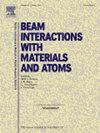X ray emission for 20 MeV to 55 MeV C4+ ions impacting on Cu target
IF 1.4
3区 物理与天体物理
Q3 INSTRUMENTS & INSTRUMENTATION
Nuclear Instruments & Methods in Physics Research Section B-beam Interactions With Materials and Atoms
Pub Date : 2025-01-18
DOI:10.1016/j.nimb.2025.165612
引用次数: 0
Abstract
The ionization of the Cu K shell by collisions of C4+ ions at energies ranging from 20 MeV to 50 MeV is studied, and the K x-ray spectra of Cu are measured using an HPGe detector. The relationship between the relative intensity ratio of Kβ and Kα x rays emitted from Cu and the kinetic energy of incident ions is investigated and compared with data for singly ionized atoms. The results show that the relative intensity ratio of Kβ to Kα x ray of Cu target decreases with the increase of incident ion kinetic energy, and the ratio is larger than the data of singly ionized atoms. The K x- ray production cross section of target atom is calculated by using the thick target cross-section formula, and compared with the results obtained from different theoretical models. The results show that the total production cross sections of Kβ and Kα x ray with the increasing incident ion kinetic energy are in close agreement with the BEA modified model which takes multiple ionization into account.
20mev ~ 55mev C4+离子撞击Cu靶的X射线发射
研究了能量为20 ~ 50 MeV的C4+离子对Cu K壳层的电离作用,并利用HPGe探测器测量了Cu的K x射线能谱。研究了Cu发射的Kβ和Kα x射线的相对强度比与入射离子动能的关系,并与单电离原子的数据进行了比较。结果表明,随着入射离子动能的增加,Cu靶Kβ与Kα x射线的相对强度比减小,且比单电离原子的数据大。利用厚靶截面公式计算了靶原子的K射线产生截面,并与不同理论模型的结果进行了比较。结果表明,随着入射离子动能的增加,Kβ和Kα x射线的总生成截面与考虑多重电离的BEA修正模型非常吻合。
本文章由计算机程序翻译,如有差异,请以英文原文为准。
求助全文
约1分钟内获得全文
求助全文
来源期刊
CiteScore
2.80
自引率
7.70%
发文量
231
审稿时长
1.9 months
期刊介绍:
Section B of Nuclear Instruments and Methods in Physics Research covers all aspects of the interaction of energetic beams with atoms, molecules and aggregate forms of matter. This includes ion beam analysis and ion beam modification of materials as well as basic data of importance for these studies. Topics of general interest include: atomic collisions in solids, particle channelling, all aspects of collision cascades, the modification of materials by energetic beams, ion implantation, irradiation - induced changes in materials, the physics and chemistry of beam interactions and the analysis of materials by all forms of energetic radiation. Modification by ion, laser and electron beams for the study of electronic materials, metals, ceramics, insulators, polymers and other important and new materials systems are included. Related studies, such as the application of ion beam analysis to biological, archaeological and geological samples as well as applications to solve problems in planetary science are also welcome. Energetic beams of interest include atomic and molecular ions, neutrons, positrons and muons, plasmas directed at surfaces, electron and photon beams, including laser treated surfaces and studies of solids by photon radiation from rotating anodes, synchrotrons, etc. In addition, the interaction between various forms of radiation and radiation-induced deposition processes are relevant.

 求助内容:
求助内容: 应助结果提醒方式:
应助结果提醒方式:


